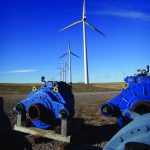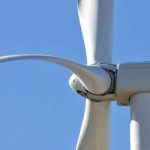Unlike previous years, AWEA Windpower 2012 held in Atlanta, had less than stellar attendance. Unfortunately, the attendance downturn will very likely parallel the downturn in wind turbine installations next year. The reasons are well known and include the uncertainty of tax credits, tight credit and general global economic forces. Everyone I talked to at the show could not begin to predict wind’s immediate future in the United States. This got me thinking about how this will affect logistics in the near future.
Four major groups will have to deal with this downturn, each being affected differently. The principle groups are; OEM (original equipment manufacturers), Developers, General Contractors, and Transportation Companies.
OEMs are already cutting back on production resulting in layoffs and reduction of capacity. This is very apparent with second tier OEMs. So, even if all the underlying issues for the downturn are resolved, it will take quite a few months to ramp up and fill the pipeline with products. Because of this, OEMs may very well buy from unaffected foreign sources. One caveat however, to this foreign sourcing could be import tariffs imposed by the US. In any case, all this uncertainty adds complexity, which makes logistics planning all that more difficult.
OEM reaction to this uncertainly may go in a couple of directions. Cutbacks may affect their logistics departments, in which case they may have to rely more on third party logistics companies for planning and execution. On the other hand especially the tier 1 manufacturers, work that was normally delegated to outside sources may be pulled back because of excess capacity. This would be done to further gain control over costs and better manage execution.
For developers, logistics costs become an even larger cost consideration. With tight budgets, keeping logistics cost down becomes a major factor in choosing who controls this item. The decision a developer has to make is whether to assume logistics control or delegate it to either the OEM or general contractor. There are good arguments for all these approaches and it also depends on the proficiency of the developer to handle logistics. But an important consideration is as the OEM cuts into its logistics capacity and knowledge, just how well will they be able to preform in the future and how much is the developer willing to take this risk.
Execution of a logistics plan has always been a focus of the general contractor. Having the right part at the right place at the right time is critical to their construction schedule. They are dependent on the capability of the logistic sources chosen by the OEM or developer. For the general contractor, they are at the end of a bullwhip, where as a slight movement at the handle in this case either the OEM or developer, results in a big movement for them. Choices by the OEM or developer will be greatly amplified as felt by the general contactor.
Finally the changes for transportation companies will be large. Excess asset capacity will be mothballed or sold. Experienced personnel will migrate to other industries. An example of this would be heavy-haul drivers driving other equipment in other industries. Transportation companies will also shift resources to other industries for diversification. There will certainly be winners and losers within the industry. With a continuing trend of less companies capable of moving wind components. This will happen through attrition and consolidation.
But all of the above is not necessarily bad for the transportation industry. The surviving companies will be stronger, more innovative and competitive. And this is good news for OEMs, developers and general contractors.
Although the show was less than well attended, I can attest to the strong belief in the wind industry by the participants and attendees. All were pragmatic about the near future, but all were optimistic about the overall wind industry, especially if and when the overall issues are resolved. Everyone I spoke with is looking forward to the show next year in Chicago, if for no other reason than to see if it is a wake or a rebirth. I am betting on the latter.
































